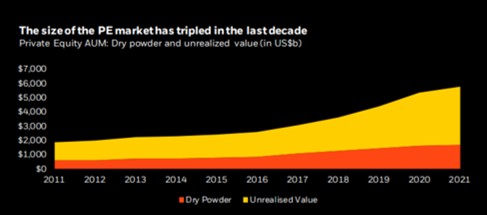Alt Investments
Private Markets Outlook Remains Strong, But Investors Must Be Choosy – BlackRock

The case for private market investment continues to grow but
public listed equities remain a major part of portfolios as
business cycles and company journeys oscillate, according to an
overview of alternative asset markets by BlackRock.
Technology, healthcare and the new ways in which people are
consuming will drive the growth of privately held businesses and
the returns they generate, the report said.
Often companies will move back and forth between listed/private
markets at different stages during their lives. The private
markets benefit from a greater pool of potential investments, but
participants need to be able to address both public and private,
or risk losing an investment relationship with a strong
corporate, BlackRock, overseeing $9.46 trillion in assets at
end-September 2021, said.
Wealth managers that cannot offer both private and public market
access will be in a difficult position, the report
said.
“A blurring of the lines is leading to increased opportunity sets
but also challenges for investors who cannot navigate across both
public and private markets, or across private markets'
verticals,” it said.
The risk premia paid on private equity and credit remains,
explaining why wealth managers, family offices and high net worth
individuals continue to put more money into such asset classes.
The size of the private equity market has tripled in the last
decade, from about $2 trillion in 2010 to more than $6 trillion
in 2021. The number of active private equity investors has also
tripled.

Source: BlackRock
That said, BlackRock expects private equity valuations, for
example, to remain strong, putting more pressure on investors and
advisors to be choosy. More than a decade of very low official
interest rates has squeezed yields on listed equities, making
less liquid, private investments more attractive by
comparison.
Private market investments – such as private equity and credit –
have exploded 30-fold from 2000 to $30.5 trillion today. US-based
firm ALTSMARK, which
provides a solution for managing, reporting and risk analysis on
private market investments,
has argued that wealth managers who lack the ability to
offer clients access to the space could go out of
business.
Drivers and tailwinds
The report, entitled 2022 Private Markets Outlook: Resilience
and Adaptation, said that the coming 12 months should see a
wider rise in real assets as markets rebound from the disruptions
of COVID-19 and associated State restrictions.
Among its predictions, the report said that private credit assets
under management are expected to expand 11 per cent per year to
$1.46 trillion by 2025
“For real assets, we see the cyclical rebound, technological
change and the response to climate change as three dominant
drivers of the outlook. At the same time, the market is driven by
a decoupled rebound due to variations in reopening strategies and
a longer-term push towards re-shored supply chains; a
differentiated market upswing across sectors, reflecting the
booming conditions in logistics, telecom and renewable power, and
a lagging recovery in air transport and hospitality; and finally
a competitive deployment stage, due to abundant capital moving
into real assets, partly reflecting a shift from other asset
classes for relatively higher and more resilient yields.
“For infrastructure markets, the outlook is marked by the 3Ds of
decarbonisation, digitalisation and decentralisation. The push to
decarbonise the global economy requires a massive energy
transition from fossil fuels to renewables, not just with the
mainstays of solar and wind, but increasingly with carbon
capture, battery storage and blue and green hydrogen. The digital
world continues to transform our daily lives, with online work,
shopping, schooling and entertainment markedly accelerated by the
pandemic, as robotics and automation deliver genuine productivity
gains.
“Moreover, infrastructure services are decentralising on several
fronts, as location becomes less important for virtual work and
shopping, and as holdings diversify for resilience and
operational efficiency.
"For real estate markets, the 3Ds of infrastructure are similarly
applicable, while we see several additional drivers at work. In
particular, the wide and sustained divergence in performance
between the winners (sheds and beds) and losers (hotels and
retail) are likely to be sustained for now, providing
considerable scope for alpha from sector selection. At the same
time, distressed and dislocated real estate segments are starting
to show signs of deep value, although these opportunities need
on-the-ground, off-market sourcing capabilities to unlock.
Looking further ahead, long-run demographic drivers remain
all-important, with local differences in population and ageing
trends making compelling cases for childcare centers in
Australia, multifamily housing in the US and senior living in
Japan,” it concluded.